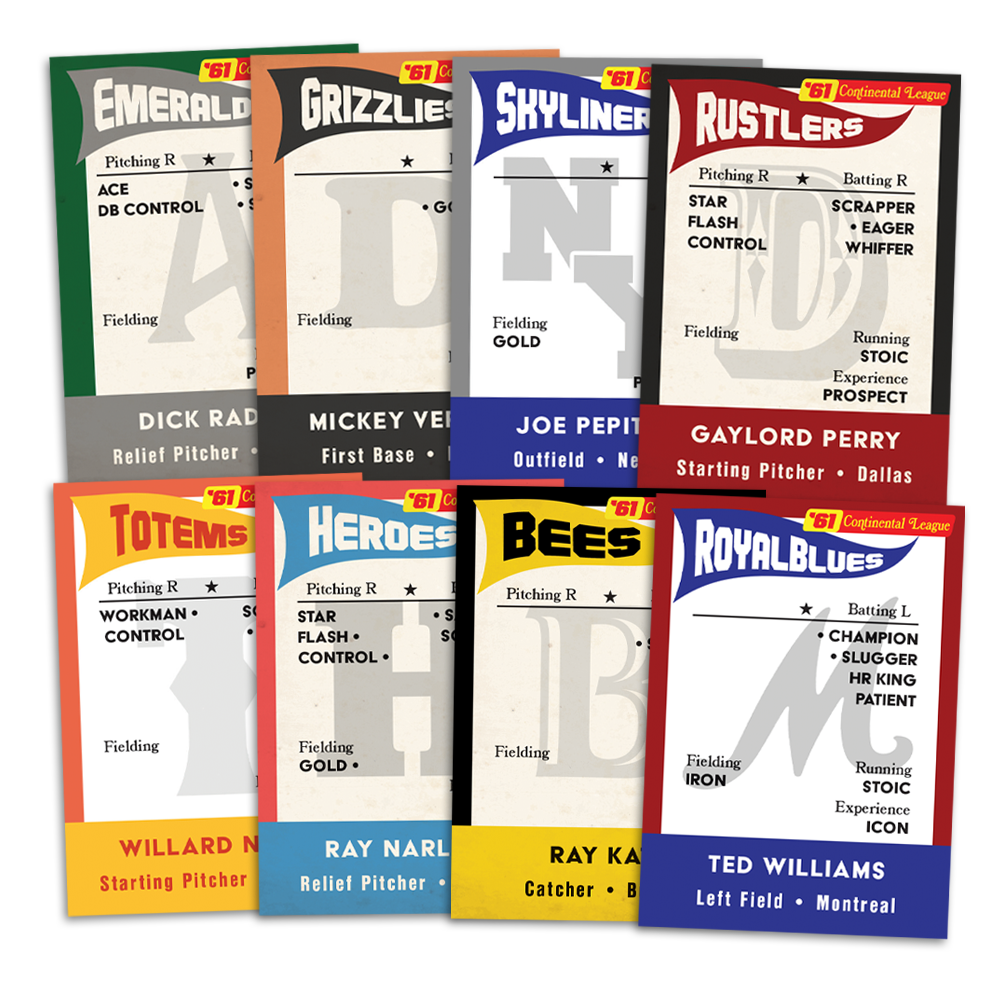1961 Continental League
Experience the greatest baseball league that never was! Real-life baseball pros take the field in this historically grounded imagining of what big league baseball’s third league could have looked like. You’ll get 240 players organized into eight fully realized teams, plus umps and ballparks, all in a vintage style that takes you back!
In the United States’ post World War II economic boom, professional sports saw a huge surge of interest. The growing population had money to spend, and the advent of television whetted its appetite for pro sports. Major US cities clamored for professional baseball, but big league baseball’s ownership was not very inclusive. Instead of adding new franchises to booming western cities like Los Angeles and San Francisco, they preferred to relocate established clubs, despite strong, loyal fan bases.
The Continental League was the idea of New York City attorney William Shea, who was perturbed by the relocation of New York’s Giants and Brooklyn’s Dodgers. On July 27, 1959, Shea announced the formation of a new eight-team professional baseball league, with teams in New York, Denver, Houston, Minneapolis–St. Paul, and Toronto. Over the next year, ten cities made formal applications for the remaining three franchises. From those, Atlanta, Buffalo and Dallas–Fort Worth were selected. Former Dodgers president Branch Rickey was named league president within a month of the league’s formation. The following February, Rickey announced Opening Day for the Continental League would be April 18, 1961. It was Rickey who famously pronounced during a guest appearance on an episode of the TV show “What’s My Line” that game play in the new Continental League was as “inevitable as tomorrow morning.”
The National Football League was facing a similar problem with the upstart American Football League. After similarly stifling expansion requests for many years, the NFL didn’t take its rival seriously--at first. But when interest in the new league surged, the NFL scrambled to thwart it by doing an about-face on expansion and adding teams in two of the AFL’s key markets. Baseball took the NFL’s cue by pre-empting the new league in Houston and Minneapolis, and--the kill shot--offering an expansion New York franchise to Shea. Thus, the Continental League officially disbanded on August 2, 1960, without ever having played a single game.
But what if the Continental League had pushed forward with its plan, like the AFL did? Likely the league would have thrived and its clubs would eventually have been absorbed into the American and National leagues in some sort of merger agreement. With this new Continental League card set for HISTORY MAKER BASEBALL, you can turn back the clock and experience how a wrinkle in baseball history might have unfolded!
You may be curious how this card set was made. We originally had the idea for this set in 2015, after completing work on a similar “what if” project for SECOND SEASON Football, the 1957 Pro Season. It included a hypothetical 1957 American Football League sub set, made up of players who theoretically could have comprised the league’s rosters if the AFL had started play a couple years sooner. We used a similar process for the ‘61 Continental League, starting with a lengthy research period. We culled the baseball archives for players who could have played in an alternate league in ‘61, intentionally avoiding players who actually DID play big league ball. Our pool of players included those whose careers ended before 1961, or whose careers began in 1962 or later but who were old enough to have played in ‘61. We stopped and started on this project for a number of years, working our way from Tommie Aaron to Gus Zernial.
For teams, we stuck with the originally-announced eight league cities, with the exception of Minneapolis (which had a team on the field in ‘61, the relocated Washington Senators). We substituted Montreal for Minneapolis, thinking that a Canadian rival for the Toronto club would have made sense. The nick-names and team colors are entirely our own creation, designed to enhance the experience. Nicknames were chosen that we felt were in keeping with the era, nothing too jazzy or futuristic.
A few observations/designer notes about the set...
• You’ll notice a preponderance of young, unproven players with a smattering of recognizable vets. This is very much the same model as the original AFL, which (wisely) focused on developing its own talent rather than raiding the existing NFL rosters. Roughly half the players in the league are PROSPECTS, and only 60 players have any kind of ICON status.
• Despite the emphasis on youth, there are some recognizable veteran players here, most prominent among them being the great Ted Williams. Wiliams retired in ‘60, but we felt he could be open to a return if it were lucrative enough. We originally gave him an open star usage symbol, a nod to his somewhat reduced workload characteristic of his final seasons in Boston. But, by popular demand, we changed that to a full-usage star. Could he have played an entire season with Montreal? We’ll leave that up to you to decide!
• A measure poetic license was a necessity in assigning players, especially with well-known future stars like Willie Stargell. Remember, the Continental League started operations in 1959, plenty of time to recruit and sign up and coming talent for the ‘61 season. Stargell was signed by the Pirates organization in ‘59, but might well have signed with or jumped to a rival league for more money. Players like Tommie Agee were less problematic. Agee signed with Cleveland in ‘61 after playing college ball at Grambling in 1960; he (and many others in this category like Dal Maxvill, Jeff Torborg, Ted Savage, etc. ) could easily have been playing in the Continental League.
• We rated players based on their actual big league performance, with special consideration for how they might have performed in 1961. As such, the overall profile of the Continental League is noticeably weaker than that of the ‘61 American and National leagues, especially in the pitching department. The positive to this is that the cards will generate what we believe will be plausible, realistic inter-league results between Continental League teams and their AL and NL counterparts.
• One area where we had to improvise a little was with umpires. We were unable to put together a complete roster of real-life big league umps who were available for the Continental League in ‘61. To fill out the umpire roster, we culled from our un-used player reserves and recruited them to serve as umpires. We’ve included 16 umps, enough for four crews.



